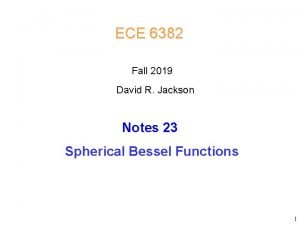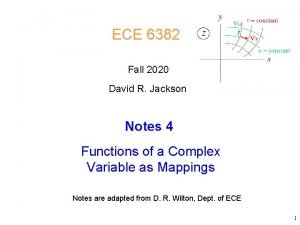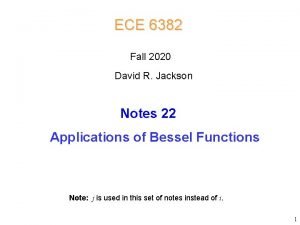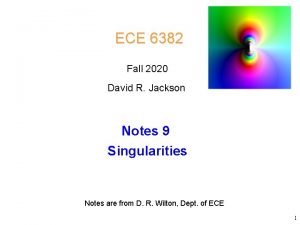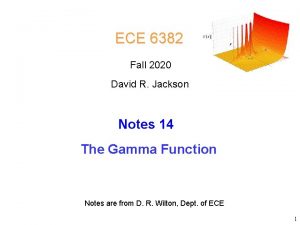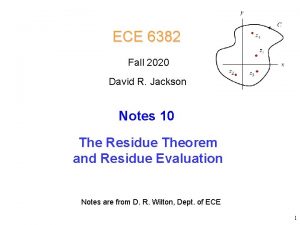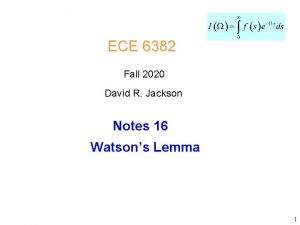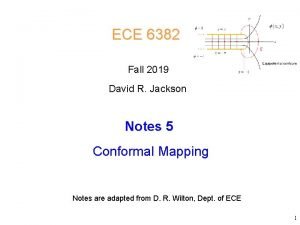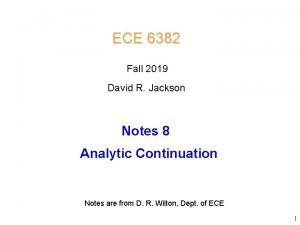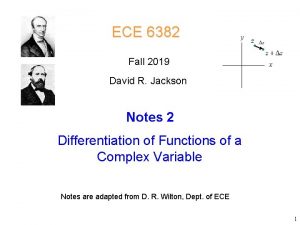ECE 6382 Fall 2020 David R Jackson Notes




















- Slides: 20

ECE 6382 Fall 2020 David R. Jackson Notes 21 Modified Bessel Functions and Kelvin Functions Notes are from D. R. Wilton, Dept. of ECE 1

Modified Bessel Functions Modified Bessel differential equation: This comes from the Bessel differential equation: The modified Bessel functions are Bessel functions of imaginary argument. 2

Modified Bessel Function of the First Kind Definition: (I is a real function of x. ) To see this, use the Frobenius solution for J : Frobenius series solution for I : 3

Second Solution of Modified Bessel Equation For n, the modified Bessel function of the 2 nd kind is defined as: For = n (an integer): 4

Relations Between Bessel and Modified Bessel Functions The modified Bessel functions are related to the regular Bessel functions as Note: The added factors in front ensure that the functions are real. *comes from: 5

Small Argument Approximations For small arguments we have: 6

Large Argument Approximations For large arguments we have: 7

Plots of Modified Bessel Functions for Real Arguments I 0 I 1 I 2 The In functions increase exponentially. They are finite at x = 0. 8

Plots of Modified Bessel Functions for Real Arguments K 1 K 2 K 0 The Kn functions decrease exponentially. The are infinite at x = 0. 9

Recurrence Relations Some recurrence relations are: 10

Wronskian A Wronskian identity is: 11

Kelvin Functions The Kelvin functions are defined as Note: These are important for studying the fields inside of a conducting wire. 12

Kelvin Functions (cont. ) The Ber functions increase exponentially. They are finite at x = 0. Ber 0 Ber 1 Ber 2 13

Kelvin Functions (cont. ) The Bei functions increase exponentially. They are finite at x = 0. Bei 1 Bei 2 Bei 0 14

Kelvin Functions (cont. ) Normalizing makes it more obvious that the Ber and Bei functions increase exponentially and also oscillate. x 15

Kelvin Functions (cont. ) Normalizing makes it more obvious that the Ber and Bei functions increase exponentially and also oscillate. x 16

Kelvin Functions (cont. ) The Ker functions decay exponentially. They are infinite at x = 0. Ker 0 Ker 1 17

Kelvin Functions (cont. ) The Kei functions decay exponentially. They are infinite at x = 0. Kei 1 18

Kelvin Functions (cont. ) Normalizing makes it more obvious that the Ker and Kei functions decrease exponentially and also oscillate. 19

Kelvin Functions (cont. ) Normalizing makes it more obvious that the Ker and Kei functions decrease exponentially and also oscillate. 20
 The life and legacy of andrew jackson doodle notes
The life and legacy of andrew jackson doodle notes David r jackson
David r jackson David r jackson
David r jackson Cs 7643 deep learning
Cs 7643 deep learning 8 great ideas in computer architecture
8 great ideas in computer architecture Cs61c fall 2020
Cs61c fall 2020 Wisc
Wisc Michael jackson x ray
Michael jackson x ray Who is in this picture
Who is in this picture David schwimmer mbti
David schwimmer mbti Compare and contrast maynard jackson and andrew young
Compare and contrast maynard jackson and andrew young The lottery shirley jackson questions
The lottery shirley jackson questions Walter jackson freeman iii
Walter jackson freeman iii General jackson slaying the many headed monster
General jackson slaying the many headed monster Michael jackson personality
Michael jackson personality Andrew jackson trail of tears map
Andrew jackson trail of tears map Why would miss strangeworth be interested in whether linda
Why would miss strangeworth be interested in whether linda The lottery shirley jackson questions
The lottery shirley jackson questions How does annabeth pay for the trip to los angeles?
How does annabeth pay for the trip to los angeles? Who is the “familiar face” that percy thinks he sees?
Who is the “familiar face” that percy thinks he sees? Percy jackson and the lightning thief chapter 12
Percy jackson and the lightning thief chapter 12


